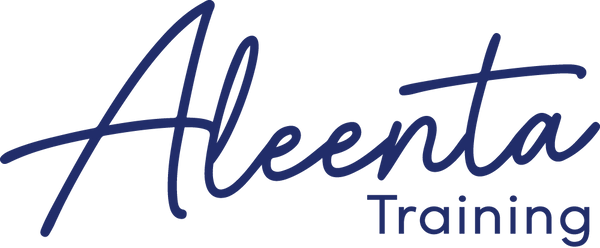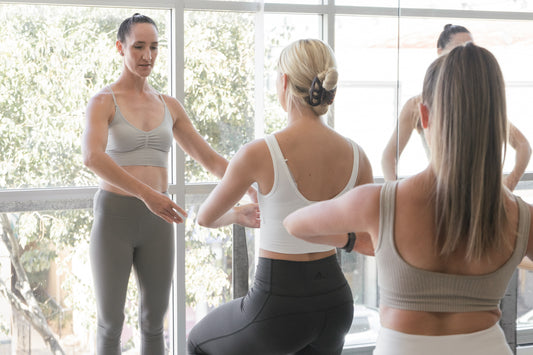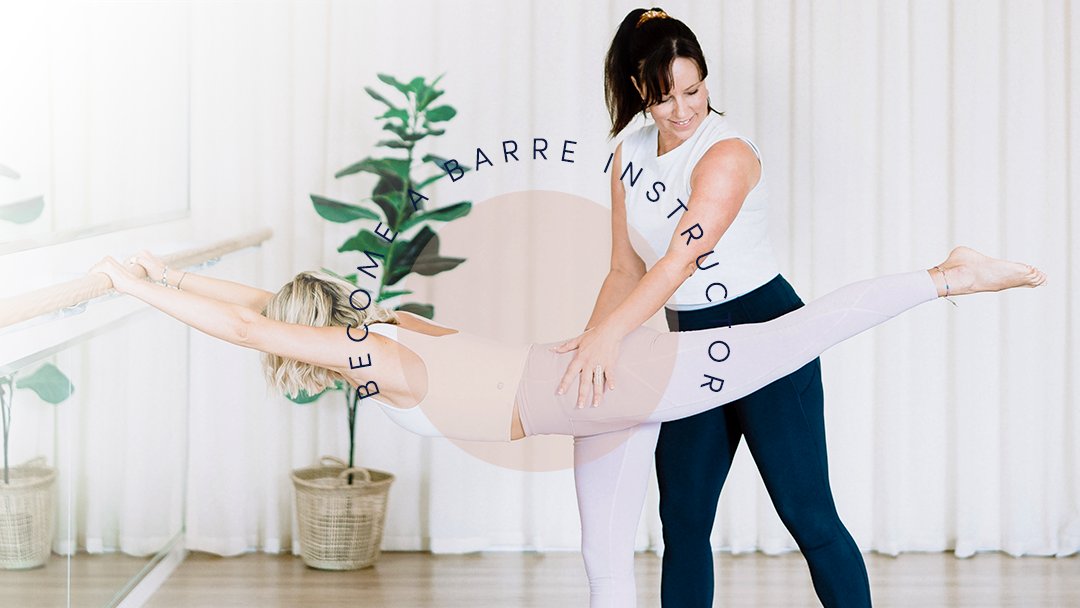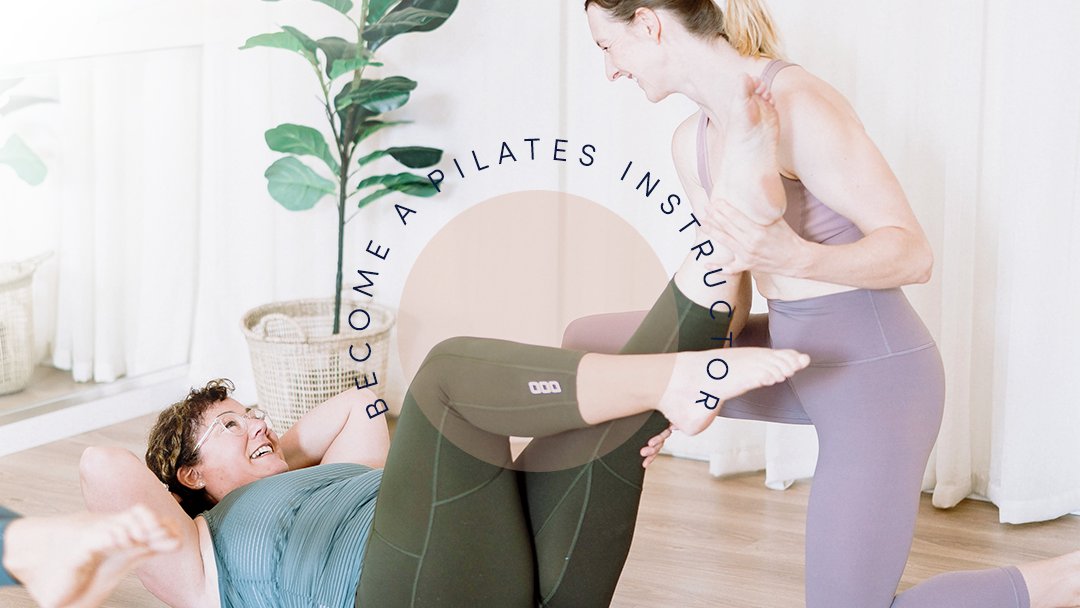Considering a career in the fitness Industry but overwhelmed with the vast choice of options available? Unsure which discipline will suit you best?
Here we'll discuss three disciplines close to our heart (and also what we offer in our Studios) and share the differences and benefits of each type of workout.
Pilates, yoga and barre all provide an effective workout from which your clients will see positive physical results. All will help to sculpt and tone your muscles and improve your overall health. Maybe you want to increase your flexibility or cardiovascular endurance, or perhaps you want to tone your muscles without bulking up or you’re favouring a past or present injury. Maybe you want to improve your core strength and posture. An awareness of your present fitness levels and future goals can help you decide which workout will benefit you the most.
All workout programs require commitment in order to achieve maximum results, so factors such as the duration, frequency, location and types of classes available may help you decide which one is a good fit for you. Your level of commitment to any fitness program hinges greatly upon your level of enjoyment with the exercise method.
With today’s demanding lifestyles, many individuals find it difficult to stick with a regular exercise program. The most common barriers to regular physical activity include lack of time and motivation. Other reported challenges include fear of injury, feelings of self-consciousness or not being athletic enough, and memories of perceived failure with prior exercise programs. Fortunately, many fitness studios offer free trials, flexible class times and even downloadable or streamed classes, so it’s easier than ever to commit.
The fitness program you ultimately choose is a personal choice and depends upon many factors. Whether it’s yoga, Pilates or barre, knowing the basic methodology of each workout option along with benefits, similarities and differences can help you to decide which one is a good fit for you.
YOGA
Yoga, which when translated from Sanskrit means “to control” or “to unite,” is said to have originated in India thousands of years ago. While its origins are based upon religion, many yoga classes today focus more on the connection between mind, body and spirit and achieving a balance within the body. Yoga concentrates heavily on body awareness, breathing and stretching.
A typical yoga class involves different types of breathing and stretching exercises. You will need a yoga mat on which you will spend the majority of your workout. A series of warm up exercises involving breathing and stretching usually begins the class. From there, you will engage in a variety of yoga positions designed to stretch and work your muscles. This involves holding your body in challenging poses designed to work a variety of muscle groups at the same time. A cool-down period with breathing exercises will end your session.
Most studios offer yoga mats for your use, but you should purchase a fitness mat if working out at home. You’ll also need comfortable clothing, as you will flex your body into a variety of positions. You will most likely be barefoot, so purchasing specific footwear is not usually necessary. Other items such as straps and balls can accompany yoga routines, but they may not be necessary right away or even at all. A water bottle and towel will help you to stay hydrated and comfortable during your class. You will be bending and stretching, so it’s best to avoid heavy meals a few hours before your class.
Flexibility is a factor in yoga, but it is not a necessary for beginner classes. Continued practice over time will increase your agility and flexibility. You can see positive results over time even if you only attend an hour a week, but attending classes around 2-3 times per week will help you experience the most benefits. Yoga classes usually last around an hour from warm-up to cool down.
YOGA BENEFITS
Yoga offers numerous benefits. Physical benefits include increased flexibility and muscle strength and tone. Regular yoga practice can decrease stiffness and joint pain and improve posture and coordination. It can also prevent you from suffering future muscle injuries. While not a high-impact method of working out, yoga is physically intense.
Yoga also offers many mental benefits, such as a reduction in stress level. Greater relaxation and reduced stress leads to a host of other positive body changes including an improvement in circulation, sleep and self-confidence. A positive mental outlook also helps to maintain a healthy immune system, which in turn can ward off other serious ailments such as high cholesterol, heart disease and stroke.
Who May Benefit Most From Yoga?
Yoga is appropriate for individuals of all ages and fitness levels. Those who are seeking a workout that increases their mind, body and spiritual awareness will find yoga to be a good fit for them. Those who wish to increase their fitness level at a slower pace may find that yoga is perfect for them, although the physical intensity is just as high as in many other exercise methods. Yoga exercises utilize a variety of muscle groups at the same time, so an entire body workout is often achieved during each class. Yoga is effective in toning muscles without creating a bulky look.
Pregnant women may find yoga to be a beneficial workout, but you should always consult your physician before engaging in any exercise program, especially during pregnancy. Individuals who want a more relaxing form of exercise while improving upon their current level of fitness will find yoga to be enjoyable. Many people benefit from the clear-headedness that comes with the deep breathing and mind-calming exercises that take place with yoga.
PILATES

Pilates is a fitness method that was developed by Joseph Pilates in Germany during World War I. Originally intended to help rehabilitate injured soldiers, Pilates broadened his method to help people of all walks of life, including police officers and dancers, to strengthen their bodies. His method stressed the use of the mind to control the muscles and was often used to help heal and build strength in individuals who were recovering from injuries.
A typical Pilates class usually lasts around 45 minutes to an hour. You need a fitness mat, water bottle and towel and comfortable clothing. Sometimes other gear such as balls, straps and Pilates-specific equipment is used. While available in most studios offering Pilates classes, these items may also be purchased if desired for home use. Like yoga, you will most likely be barefoot during workouts.
Pilates classes involve a series of positions and body movements, all with different names. Deep concentration is required to place your body into the various positions and hold it there. Modifications on these positions can be made to accommodate people of all abilities and fitness levels.
Pilates uses your body weight for resistance and focuses on working both small and large groups of muscles. Over time, core strength, flexibility and muscle tone will begin to increase. Maximum results are achieved by working out at least 3 days a week. Pilates is not an aerobic exercise method, so it’s best to combine it with a few days of cardiovascular exercise. Although the movements are small and slow, Pilates provides an intense full-body workout.
Benefits of Pilates
The physical benefits of Pilates include an increase in muscle strength and tone without creating bulk. The increase in deep core muscle strength helps to make your abdominal muscles look tight and toned. It also improves your flexibility and posture, which can decrease your chances of injuring yourself. Pilates is also effective in easing chronic lower back pain and preventing future back pain and injuries.
The mental benefits of Pilates include an increase in the ability to focus. It takes a great deal of concentration to coordinate your breath and body position during workouts. In fact, Joseph Pilates often referred to his method as “the thinking man’s exercise” due to the improvement in memory and other cognitive functions that results from doing it. A clear mind also reduces stress levels, which translates to an improvement in your overall health.
Who may Benefit Most from Pilates?
Pilates is great for individuals of all fitness levels. People who are just beginning a fitness program will find it’s a great way to ease into more intense methods of exercise. It’s also beneficial for pregnant and postpartum women and people wishing to strengthen their muscles after an injury. A physician’s approval should be sought before beginning any exercise program.
People who enjoy yoga but may be looking for a more vigorous core workout can benefit from Pilates, as they both incorporate similar mind-clearing techniques. Pilates is great for people who desire a full-body workout during each class. Though an intense fitness method, Pilates provides an effective workout with minimal impact on the joints.
BARRE
A popular workout program that is rapidly gaining recognition and followers is the barre method. This fitness program is essentially a mixture of ballet-inspired exercises, yoga and Pilates. Barre derives from the Lotte Berk Method founded in 1959 in London by its namesake, a German dancer looking to stay fit while nursing a back injury.
In the barre fitness method, a dancer’s barre and a mat are used. While an intense and effective workout method, no previous dance experience is required. The barre method is accepting of all fitness and ability levels.
The barre method uses your own body weight for resistance and focuses on small, deliberate movements that focus on specific groups of muscles, specifically muscles that aren’t used in other workouts. Muscles are worked to the point of fatigue, and then stretched for relief. Proper form, body alignment and posture is stressed, which in turn leads to an overall strengthening of core muscles and the appearance of an aligned, lean body.
Aerobic exercise is also be used in this method, as the idea is to increase cardiovascular endurance while increasing the body’s metabolism to burn fat. It can be quite intense, with classes lasting on average 60 minutes. Increased stamina is achieved by allowing very little rest between activities so muscles stay engaged.
Barre workouts require minimal equipment. You’ll need a free-standing or wall mounted bar and a mat. Sometimes a soft exercise ball may be used during leg workouts. If you are taking classes in a studio, the required equipment will most likely be provided for you. If you are working out at home, bars can be purchased for home use. You may prefer to be barefoot or purchase socks with grips on the bottom. As with all other workouts, having a water bottle and towel nearby is helpful.
Barre Benefits
Perhaps one of the best benefits of barre is that it’s fun! It incorporates the use of upbeat music and engaging choreography. When working out is fun and enjoyable, your chances of staying with the program greatly increase. The barre method also offers quick results. Barre helps strengthen and tone your muscles without increasing bulk, and it improves your posture. It also increases cardiovascular endurance and metabolism, which helps to quickly burn calories.
Regular barre workouts can increase your bone density, which can help prevent conditions like osteoporosis. They can also help you avoid injury. The small isometric muscle movements used during barre classes build muscle strength without putting a strain on ligaments and tendons like other fitness training methods can.
The mental benefits of barre are similar to yoga and Pilates, as it effectively increases mind-body awareness and mental clarity. Focus and concentration are required to perform the small precise movements utilized in barre. Allowing your mind to concentrate solely on your technique increases feelings of relaxation and decreases stress levels. Endorphins released during physical activity increase your general sense of well-being.
Who may benefit most from Barre?
Barre workouts are appropriate for individuals of all fitness levels. It is ideal for individuals who wish to improve their core strength and posture. Many of us often sit in a hunched position at a desk or in front of a computer for long periods, and it takes its toll over time. Barre is appropriate for individuals who are seeking an intense but low-impact workout that will offer quick results.
Barre is also best for people who wish to work out their whole body every time they work out. Barre’s focus on small, isolated groups of muscles means that you will most likely be sore after each workout. Both former dancers and also those with no prior dance experience will enjoy and benefit from the upbeat nature of barre workouts.
Barre vs Yoga vs Pilates - Which is right for you?
The best news is that you don't necessarily have to choose one! These days a key benefit of being a group fitness Instructor is that you can teach a variety of classes. And we recommend choosing what you are most passionate about. If you absolutely love yoga, then take a yoga Instructor Course. There are an amazing range of Yoga Instructor Courses available.
If you're interested in Pilates or Barre and can't decide, we always recommend Pilates as an awesome place to start. Why?
Because barre fitness incorporates a lot of Pilates exercises and technique and understanding Pilates will also help you as a Barre Instructor.
Still trying to decide? Reach out to hello@aleentabarre.com and we'd love to chat more and learn about your circumstances and what will work best for you.










